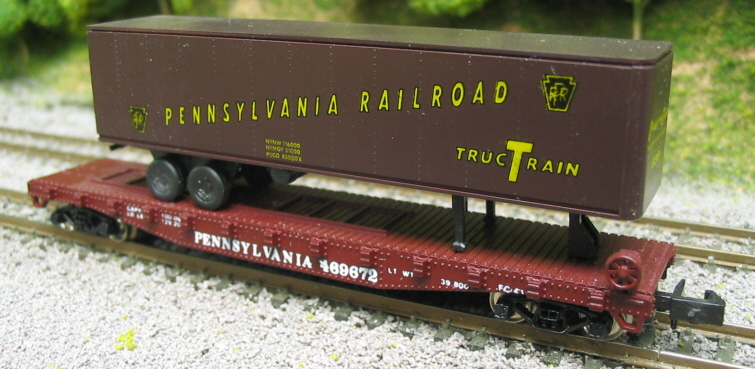

These cars were originally manufactured in Tucson. Production may have eventually been relocated to China, although I'm not sure about that. I'm told that this car is plastic with an alloy underframe. At least some of these are stamped "Sekisui Kinzoku" (IE, Kato) on the bottom - this due to the fact that Con-Cor recycled old Kato tooling from earlier cars and didn't bother to remove the wording from the old die-cast parts.
The economic success of the railroads depended on freight shipped in full cars. The idea of putting truck trailers on flatcars was a method of moving less-than-carload shipments economically. This “intermodal” concept held the hope of competing with trucks which were taking more and more of this business from the railroads.
In the mid-thirties, the Chicago, the Great Western and then the New Haven railroads began piggy back service limited to their own railroad. By 1953, the CB&Q, the Eastern Illinois and the Southern Pacific railroads had joined the innovation. Most cars were surplus 50’s flatcars equipped with new decks by the railroads. By 1955, an additional 25 railroads had begun some form of piggy back service. A significant legal battle between the truckers and the railroads resulted in a ruling permitting interstate piggy back service using either railroad or privately owned trailers. The stage was set for rapid expansion of intermodal services.
After Trailer-Train incorporated in 1955, they and many other railroads began to build 75 foot cars. Most cities had piggy back facilities. Many small towns had their own ramp for ‘circus style’ loading. Some of the railroads offering this service were: B&O, CB&Q, CGW, C&EI, C&NW, C&O, DL&W, D&RGW, ERIE, GN, KCS, LV, MDT, Nickleplate, NYC, PENNSY, SF, SP, WABASH and WM.
Another landmark was the introduction of the ACF Model A mechanical hitch in 1956. Until that time, trailers were secured to the flatcars with ropes and other time-consuming tie-down methods. In 1961, the Model 2 hitch was introduced and, later, many other types.
Trucks with trailers became a viable transportation business in the 1930’s. Early trailers had round noses and were mostly 20 feet long. Box, refrigerator and open top designs with smooth or horizontal corrugated sides were common. Most used only one axle. After World War II, the 35 foot trailers became much more popular with long haul truckers. Flat nose trailers with vertical post sides also were being built in greater numbers. In the early fifties, the round nose trailers were still the most common, but few were being built. In 1958, the 40 foot trailer became legal and most production of long haul trailers switched to this length. Vertical post trailers with flat noses were the most common design, but smooth and corrugated trailers were still being built. This situation remained little changed well into the 70’s. Tractors and trailers last for many years and occasionally a short, round nose trailer could still be seen in local service in the 80‘s.